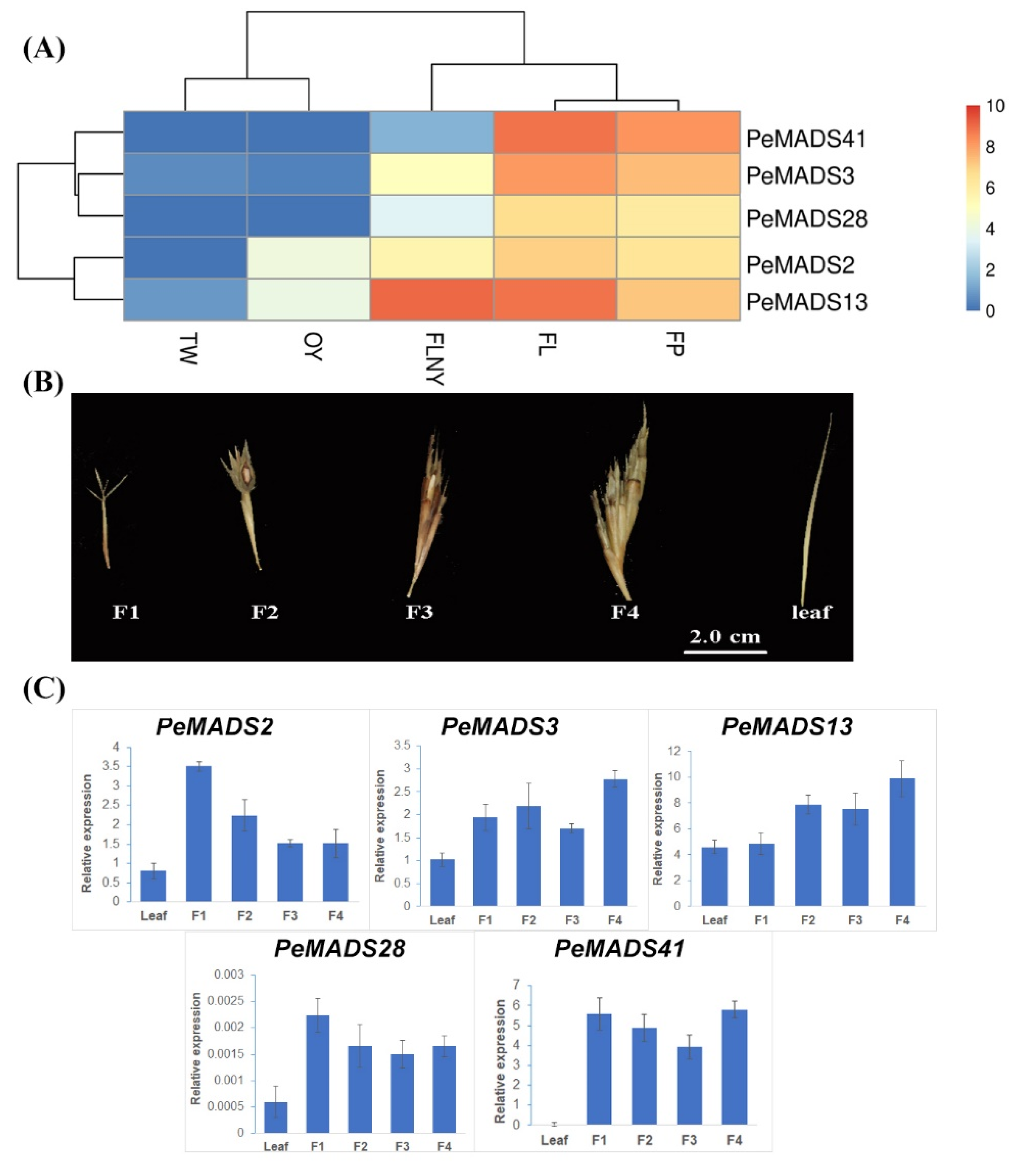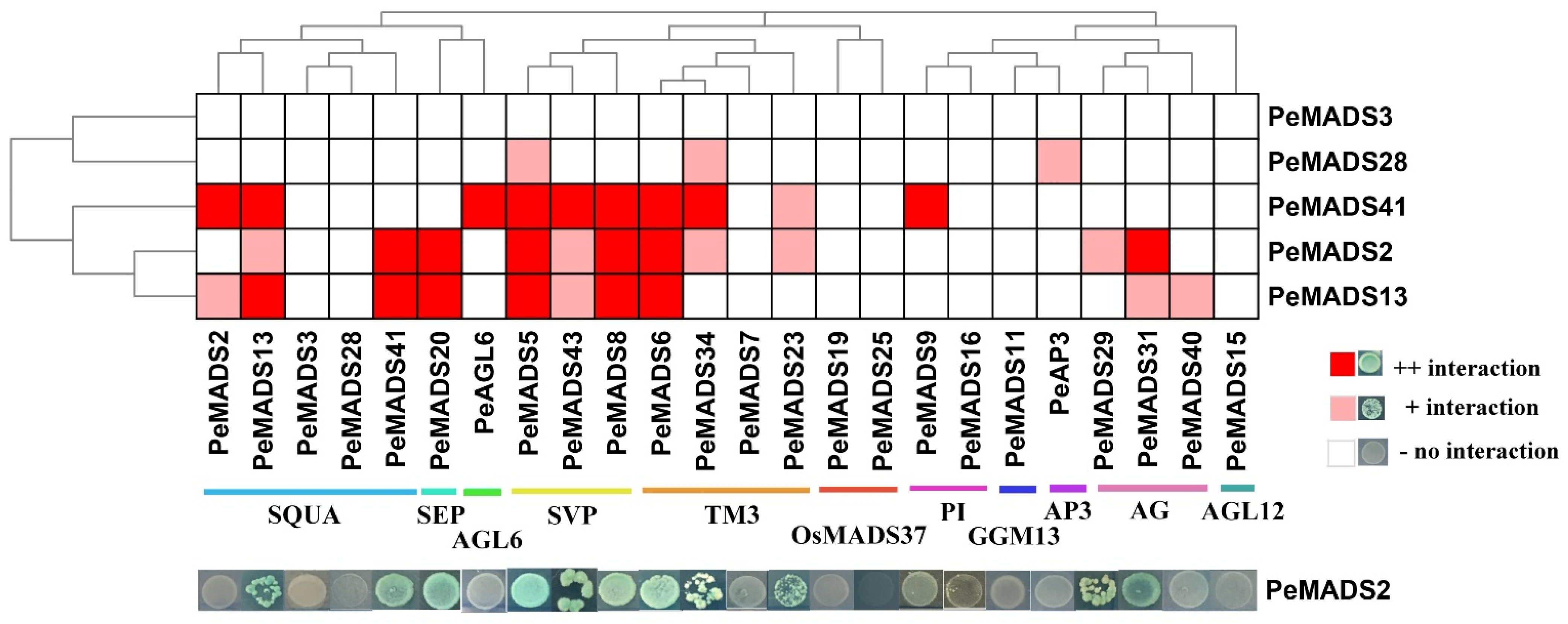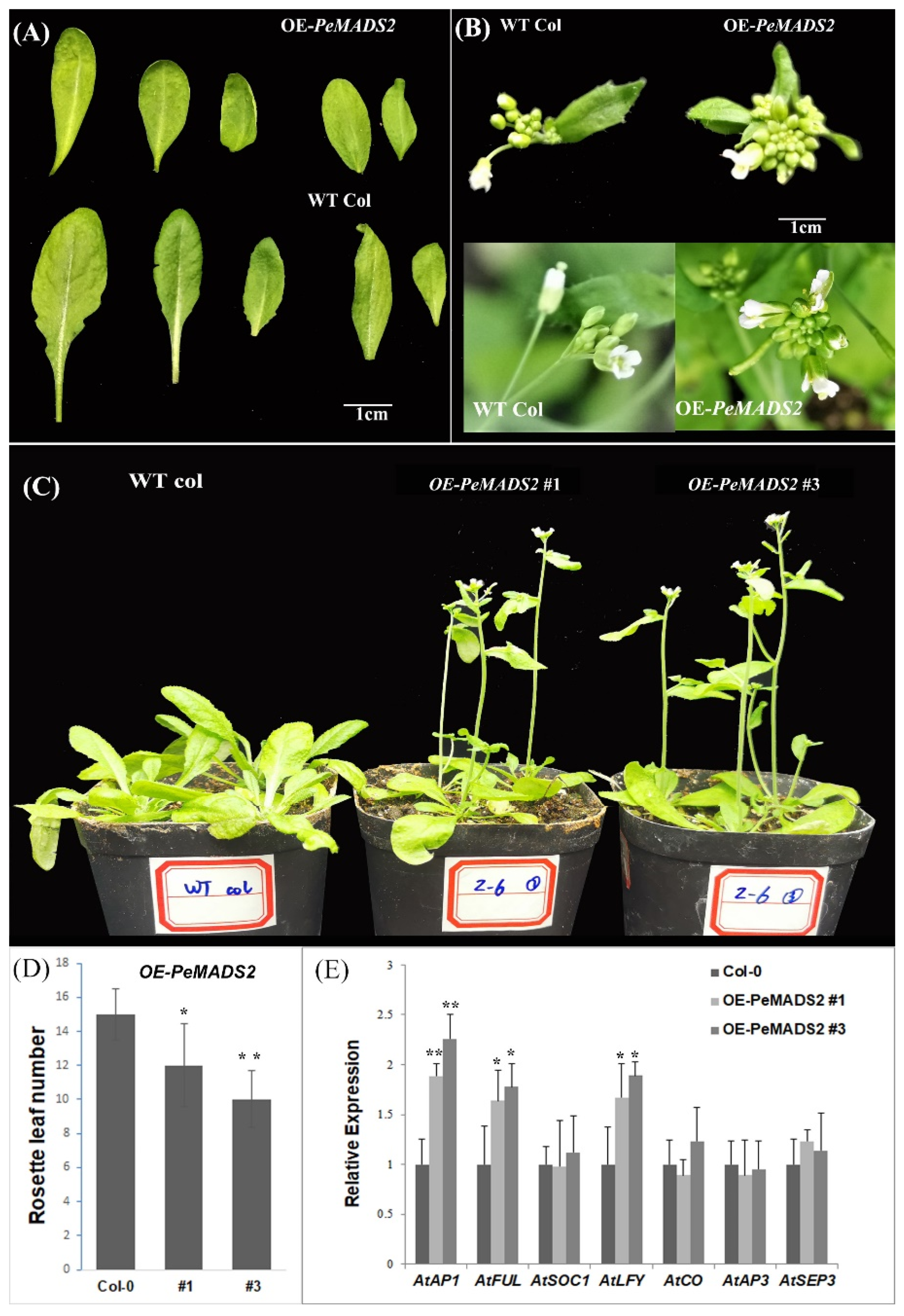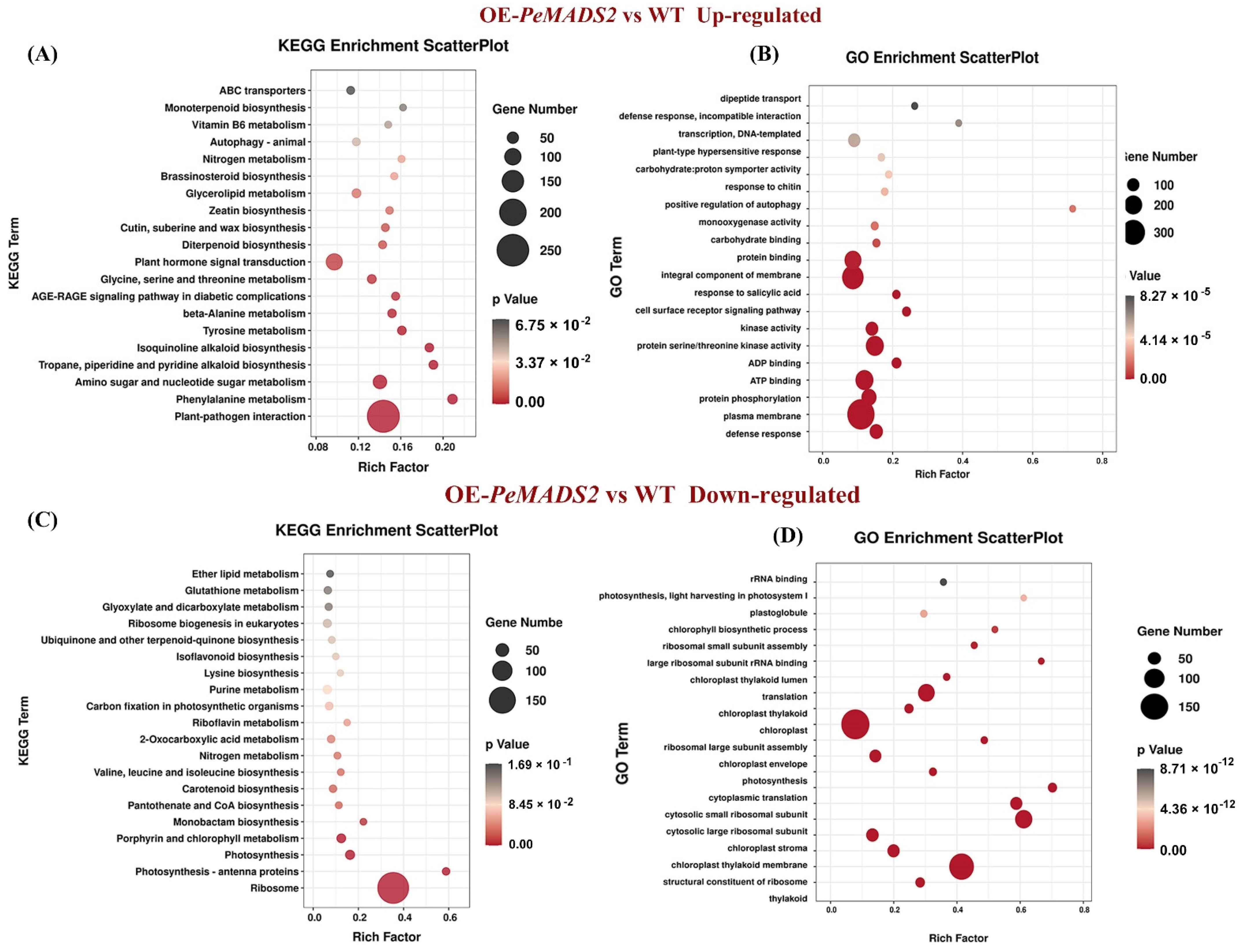Comprehensive Analysis of Five Phyllostachys edulis SQUA-like Genes and Their Potential Functions in Flower Development
Abstract
:1. Introduction
2. Results
2.1. The Bioinformatics Analysis of Five SQUA-like Members in P. edulis
2.2. Expression Analysis of PeSQUA-like Genes during Different Flowering Stages
2.3. PPI between PeSQUA-like Members and Other MADS-Box Proteins in P. edulis
2.4. Ectopic Expression of PeMADS2 Accelerates Arabidopsis Flowering
2.5. Ectopic Expression of PeMADS2 Promotes Rice Flowering
2.6. Analysis of Differential Gene Expression in OE-PeMADS2 Transgenic Rice
3. Discussion
3.1. Gene Expression Patterns and PPI Patterns Are Divergent among PeSQUA-like Genes
3.2. PPI Patterns of PeSQUAs Alternating from Vegetative to Reproductive Growth
3.3. PeMADS2 Acts as a Flowering Promoter in Transgenic Arabidopsis
3.4. Ectopic Expression of PeMADS2 Triggered Multiple Flower Signaling Pathways to Induce Early Flowering in Rice
4. Materials and Methods
4.1. Plant Materials and Growth Conditions
4.2. Gene Cloning and Phylogenetic Analysis
4.3. DGE Data and Transcriptome Data Analysis
4.4. Yeast Two-Hybrid Analysis
4.5. Binary Plasmid Construction and Analysis of Transgenic Plants
4.6. RNA Extraction, and Quantitative RT–PCR (qPCR) Analysis
4.7. RNA-seq, KEGG, and GO Analysis
5. Conclusions
Supplementary Materials
Author Contributions
Funding
Institutional Review Board Statement
Informed Consent Statement
Data Availability Statement
Conflicts of Interest
References
- Ramakrishnan, M.; Yrjälä, K.; Vinod, K.K.; Sharma, A.; Cho, J.; Satheesh, V.; Zhou, M. Genetics and Genomics of Moso Bamboo (Phyllostachys edulis): Current Status, Future Challenges, and Biotechnological Opportunities toward a Sustainable Bamboo Industry. Food Energy Secur. 2020, 9, e229. [Google Scholar] [CrossRef]
- Dutta, S.; Biswas, P.; Chakraborty, S.; Mitra, D.; Pal, A.; Das, M. Identification, Characterization and Gene Expression Analyses of Important Flowering Genes Related to Photoperiodic Pathway in Bamboo. BMC Genom. 2018, 19, 1–19. [Google Scholar] [CrossRef] [PubMed] [Green Version]
- Isagi, Y.; Shimada, K.; Kushima, H.; Tanaka, N.; Nagao, A.; Ishikawa, T.; Onodera, H.; Watanabe, S. Clonal Structure and Flowering Traits of a Bamboo [Phyllostachys pubescens (Mazel) Ohwi] Stand Grown from a Simultaneous Flowering as Revealed by AFLP Analysis. Mol. Ecol. 2004, 13, 2017–2021. [Google Scholar] [CrossRef]
- Wysocki, W.P.; Eduardo, R.S.; Yin, Y.; Duvall, M.R. The Floral Transcriptomes of Four Bamboo Species (Bambusoideae; Po-aceae): Support for Common Ancestry among Woody Bamboos. BMC Genom. 2016, 17, 384. [Google Scholar] [CrossRef] [PubMed] [Green Version]
- Biswas, P.; Chakraborty, S.; Dutta, S.; Pal, A.; Das, M. Bamboo Flowering from the Perspective of Comparative Genomics and Transcriptomics. Front. Plant Sci. 2016, 7, 1900. [Google Scholar] [CrossRef] [PubMed] [Green Version]
- Hou, D.; Li, L.; Ma, T.; Pei, J.; Zhao, Z.; Lu, M.; Wu, A.; Lin, X. The SOC1-like Gene BoMADS50 is Associated with the Flowering of Bambusa oldhamii. Hortic. Res. 2021, 8, 1–13. [Google Scholar] [CrossRef]
- Gao, J.; Zhang, Y.; Zhang, C.; Qi, F.; Li, X.; Mu, S.; Peng, Z. Characterization of the Floral Transcriptome of Moso Bamboo (Phyllostachys edulis) at Different Flowering Developmental Stages by Transcriptome Sequencing and RNA-Seq Analysis. PLoS ONE 2014, 9, e98910. [Google Scholar] [CrossRef] [Green Version]
- Shih, M.C.; Chou, M.L.; Yue, J.J.; Hsu, C.T.; Chang, W.J.; Ko, S.S.; Liao, D.C.; Huang, Y.T.; Chen, J.J.; Yuan, J.L.; et al. BeMADS1 is a Key to Delivery MADSs into Nucleus in Reproductive Tissues-De Novo Characterization of Bambusa edulis Transcriptome and Study of MADS Genes in Bamboo Floral Development. BMC Plant Biol. 2014, 14, 179. [Google Scholar] [CrossRef] [Green Version]
- Liu, S.; Qi, T.; Ma, J.; Ma, T.; Ma, L.; Lin, X. Ectopic Expression of a SOC1 Homolog from Phyllostachys Violascens Alters Flowering Time and Identity of Floral Organs in Arabidopsis thaliana. Trees 2016, 30, 2203–2215. [Google Scholar] [CrossRef]
- Liu, S.; Ma, T.; Ma, L.; Lin, X. Ectopic Expression of PvSOC1, a Homolog of SOC1 from Phyllostachys violascens, Promotes Flowering in Arabidopsis and Rice. Acta Physiol. Plant. 2016, 38, 1–9. [Google Scholar] [CrossRef]
- Zhang, Y.; Tang, D.; Lin, X.; Ding, M.; Tong, Z. Genome-Wide Identification of MADS-Box Family Genes in Moso Bamboo (Phyllostachys edulis) and a Functional Analysis of PeMADS5 in Flowering. BMC Plant Biol. 2018, 18, 176. [Google Scholar] [CrossRef]
- Zhang, H.; Forde, B.G. An Arabidopsis MADS Box Gene that Controls Nutrient-Induced Changes in Root Architecture. Science 1998, 279, 407–409. [Google Scholar] [CrossRef]
- Alvarez-Buylla, E.R.; Pelaz, S.; Liljegren, S.J.; Gold, S.E.; Burgeff, C.; Ditta, G.S.; de Pouplana, L.R.; Martínez-Castilla, L.; Yanofsky, M.F. An Ancestral MADS-Box Gene Duplication Occurred before the Divergence of Plants and Animals. Proc. Natl. Acad. Sci. USA 2000, 97, 5328–5333. [Google Scholar] [CrossRef] [Green Version]
- Ng, M.; Yanofsky, M.F. Function and Evolution of the Plant MADS-box Gene Family. Nat. Rev. Genet. 2001, 2, 186–195. [Google Scholar] [CrossRef] [PubMed]
- Gramzow, L.; Theissen, G. A Hitchhiker’s Guide to the MADS World of Plants. Genome Biol. 2010, 11, 214. [Google Scholar] [CrossRef] [Green Version]
- Gramzow, L.; Weilandt, L.; Theißen, G. MADS Goes Genomic in Conifers: Towards Determining the Ancestral Set of MADS-Box Genes in Seed Plants. Ann. Bot. 2014, 114, 1407–1429. [Google Scholar] [CrossRef] [PubMed] [Green Version]
- Chen, C.; Begcy, K.; Liu, K.; Folsom, J.J.; Wang, Z.; Zhang, C.; Walia, H. Heat Stress Yields a Unique MADS Box Transcription Factor in Determining Seed Size and Thermal Sensitivity. Plant Physiol. 2016, 171, 606–622. [Google Scholar] [CrossRef] [PubMed] [Green Version]
- Peng, Z.; Lu, Y.; Li, L.; Zhao, Q.; Feng, Q.; Gao, Z.; Lu, H.; Hu, T.; Yao, N.; Liu, K.; et al. The Draft Genome of the Fast-Growing Non-Timber Forest Species Moso Bamboo (Phyllostachys heterocycla). Nat. Genet. 2013, 45, 456–461. [Google Scholar] [CrossRef] [Green Version]
- Litt, A.; Irish, V.F. Duplication and Diversification in the APETALA1/FRUITFULL Floral Homeotic Gene Lineage: Implications for the Evolution of Floral Development. J. Gen. 2003, 165, 821–833. [Google Scholar] [CrossRef]
- Wu, F.; Shi, X.; Lin, X.; Liu, Y.; Chong, K.; Theißen, G.; Meng, Z. The ABCs of Flower Development: Mutational Analysis of AP1/FUL-like Genes in Rice Provides Evidence for a Homeotic (A)-Function in Grasses. Plant J. 2016, 89, 310–324. [Google Scholar] [CrossRef]
- Ferrandiz, C.; Gu, Q.; Martienssen, R.; Yanofsky, M. Redundant Regulation of Meristem Identity and Plant Architecture by FRUITFULL, APETALA1 and CAULIFLOWER. Development 2000, 127, 725–734. [Google Scholar] [CrossRef] [PubMed]
- Gu, Q.; Ferrandiz, C.; Yanofsky, M.; Martienssen, R. The FRUITFULL MADS-Box Gene Mediates Cell Differentiation During Arabidopsis Fruit Development. Development 1998, 125, 1509–1517. [Google Scholar] [CrossRef]
- Kobayashi, K.; Yasuno, N.; Sato, Y.; Yoda, M.; Yamazaki, R.; Kimizu, M.; Yoshida, H.; Nagamura, Y.; Kyozuka, J. Inflorescence Meristem Identity in Rice Is Specified by Overlapping Functions of Three AP1/FUL-like MADS Box Genes and PAP2, a SEPALLATA MADS Box Gene. Plant Cell 2012, 24, 1848–1859. [Google Scholar] [CrossRef] [Green Version]
- Jeon, J.-S.; Lee, S.; Jung, K.H.; Yang, W.-S.; Yi, G.-H.; Oh, B.-G.; An, G. Production of Transgenic Rice Plants Showing Reduced Heading Date and Plant Height by Ectopic Expression of Rice MADS-box Genes. Mol. Breed. 2000, 6, 581–592. [Google Scholar] [CrossRef]
- Fornara, F.; Pařenicová, L.; Falasca, G.; Pelucchi, N.; Masiero, S.; Ciannamea, S.; Lopez-Dee, Z.; Altamura, M.M.; Colombo, L.; Kater, M.M. Functional Characterization of OsMADS18, a Member of the AP1/SQUA Subfamily of MADS Box Genes. Plant Physiol. 2004, 135, 2207–2219. [Google Scholar] [CrossRef] [PubMed] [Green Version]
- Li, C.; Lin, H.; Chen, A.; Lau, M.; Jernstedt, J.; Dubcovsky, J. Wheat VRN1, FUL2 and FUL3 Play Critical and Redundant Roles in Spikelet Development and Spike Determinacy. Development 2019, 146, 175398. [Google Scholar] [CrossRef] [PubMed] [Green Version]
- Preston, J.C.; Kellogg, E.A. Discrete Developmental Roles for Temperate Cereal Grass VERNALIZATION1/FRUITFULL-like Genes in Flowering Competency and the Transition to Flowering. Plant Physiol. 2008, 146, 265–276. [Google Scholar] [CrossRef] [PubMed] [Green Version]
- Lin, E.P.; Peng, H.Z.; Jin, Q.Y.; Deng, M.J.; Li, T.; Xiao, X.C.; Hua, X.Q.; Wang, K.H.; Bian, H.W.; Han, N. Identification and characterization of two Bamboo (Phyllostachys praecox) AP1 / SQUA- like MADS-Box Genes during Floral Transition. Planta 2009, 231, 109–120. [Google Scholar] [CrossRef]
- Vandenbussche, M.; Theissen, G.; Van, P.; Gerats, T. Structural Diversification and Neo-Functionalization during Floral MADS-Box Gene Evolution by C-Terminal Frameshift Mutations. Nucleic Acids Res. 2003, 31, 4401–4409. [Google Scholar] [CrossRef]
- Zhang, Z.; Wang, H.; Wang, Y.; Xi, F.; Wang, H.; Kohnen, M.V.; Gao, P.; Wei, W.; Chen, K.; Liu, X.; et al. Whole-Genome Characterization of Chronological Age-Associated Changes in Methylome and Circular RNAs in Moso Bamboo (Phyllostachys edulis) from Vegetative to Floral Growth. Plant J. 2021, 106, 435–453. [Google Scholar] [CrossRef] [PubMed]
- Li, X.; Tian, F.; Song, J.; Wei, S.; Xia, K.; Liao, J.; Zhang, M. Functional Conservation and Divergence of Four Ginger AP1/AGL9 MADS–Box Genes Revealed by Analysis of Their Expression and Protein–Protein Interaction, and Ectopic Expression of AhFUL Gene in Arabidopsis. PLoS ONE 2014, 9, e114134. [Google Scholar] [CrossRef] [Green Version]
- Mccarthy, E.W.; Abeer, M.; Amy, L. Functional Divergence of APETALA1 and FRUITFULL is Due to Changes in Both Regulation and Coding Sequence. Front. Plant Sci. 2015, 6, 1076. [Google Scholar] [CrossRef] [Green Version]
- Preston, J.C.; Kellogg, E.A. Conservation and Divergence of APETALA1/FRUITFULL-like Gene Function in Grasses: Evidence from Gene Expression Analyses. Plant J. 2007, 52, 69–81. [Google Scholar] [CrossRef] [PubMed]
- Yin, X.; Liu, X.; Xu, B.; Lu, P.; Dong, T. OsMADS18, a Membrane-Bound MADS-Box Transcription Factor, Modulates Plant Architecture and the ABA Response in Rice. J. Exp. Bot. 2019, 70, 3895–3909. [Google Scholar] [CrossRef] [PubMed] [Green Version]
- Callens, C.; Tucker, M.R.; Zhang, D.; Wilson, Z.A. Dissecting the Role of MADS-Box Genes in Monocot Floral Development and Diversity. J. Exp. Bot. 2018, 69, 2435–2459. [Google Scholar] [CrossRef] [PubMed]
- Immink, R.; Kaufmann, K.; Angenent, G. The ‘ABC’ of MADS Domain Protein Behaviour and Interactions. Semin. Cell Dev. Biol. 2010, 21, 87–93. [Google Scholar] [CrossRef]
- Adam, H.; Ouellet, F.; Kane, N.A.; Agharbaoui, Z.; Major, G.; Tominaga, Y.; Sarhan, F. Overexpression of TaVRN1 in Arabidopsis Promotes Early Flowering and Alters Development. Plant Cell Physiol. 2007, 48, 1192–1206. [Google Scholar] [CrossRef] [Green Version]
- Folter, S.D.; Angenent, G.C. Trans meets Cis in MADS Science. Trends Plant Sci. 2006, 11, 224–231. [Google Scholar] [CrossRef]
- Moyroud, E.; Kusters, E.; Monniaux, M.; Koes, R.; Parcy, F. LEAFY Blossoms. Trends Plant Sci. 2010, 15, 346–352. [Google Scholar] [CrossRef]
- Zhao, J.; Chen, H.; Ren, D.; Tang, H.; Qiu, R.; Feng, J.; Long, Y.; Niu, B.; Chen, D.; Zhong, T.; et al. Genetic Interactions Between Diverged Alleles of Early Heading Date 1 (Ehd1) and Heading date 3a (Hd3a)/ RICE FLOWERING LOCUS T1 (RFT1) Control Differential Heading and Contribute to Regional Adaptation in Rice (Oryza sativa). New Phytol. 2015, 208, 936–948. [Google Scholar] [CrossRef]
- Kim, S.L.; Lee, S.; Kim, H.J.; Gil Nam, H.; An, G. OsMADS51 Is a Short-Day Flowering Promoter That Functions Upstream of Ehd1, OsMADS14, and Hd3a. Plant Physiol. 2007, 145, 1484–1494. [Google Scholar] [CrossRef] [Green Version]
- Li, D.; Yang, C.; Li, X.; Gan, Q.; Zhao, X.; Zhu, L. Functional Characterization of Rice OsDof12. Planta 2009, 229, 1159–1169. [Google Scholar] [CrossRef]
- Liu, J.; Cheng, Z.; Xie, L.; Li, X.; Gao, J. Multifaceted Role of PheDof12-1 in the Regulation of Flowering Time and Abiotic Stress Responses in Moso Bamboo (Phyllostachys edulis). Int. J. Mol. Sci. 2019, 20, 424. [Google Scholar] [CrossRef] [PubMed] [Green Version]
- Wei, X.; Xu, J.; Guo, H.; Jiang, L.; Chen, S.; Yu, C.; Zhou, Z.; Hu, P.; Zhai, H.; Wan, J. DTH8 Suppresses Flowering in Rice, Influencing Plant Height and Yield Potential Simultaneously. Plant Physiol. 2010, 153, 1747–1758. [Google Scholar] [CrossRef] [PubMed] [Green Version]
- Hiroyuki, T.; Kenichiro, T.; Ko, S. Regulation of Flowering in Rice: Two Florigen Genes, a Complex Gene Network, and Natural Variation. Curr. Opin. Plant. Biol. 2011, 14, 45–52. [Google Scholar]
- Komiya, R.; Ikegami, A.; Tamaki, S.; Yokoi, S.; Shimamoto, K. Hd3a and RFT1 are Essential for Flowering in Rice. Development 2008, 135, 767–774. [Google Scholar] [CrossRef] [PubMed] [Green Version]
- Zhang, J.; Cai, Y.; Yan, H.; Jin, J.; You, X.; Wang, L.; Kong, F.; Zheng, M.; Wang, G.; Jiang, L.; et al. A Critical Role of OsMADS1 in the Development of the Body of the Palea in Rice. J. Plant Biol. 2018, 61, 11–24. [Google Scholar] [CrossRef]
- Jeon, J.S.; Jang, S.; Lee, S.; Nam, J.; Kim, C.; Lee, S.H.; Chung, Y.Y.; Kim, S.R.; Lee, Y.H.; Cho, Y.G.; et al. Leafy Hull Sterile1 Is a Homeotic Mutation in a Rice MADS Box Gene Affecting Rice Flower Development. Plant Cell 2000, 12, 871–884. [Google Scholar] [CrossRef] [Green Version]
- Lim, J.; Moon, Y.H.; An, G.; Jang, S.K. Two Rice MADS Domain Proteins Interact with OsMADS1. Plant Mol. Biol. 2000, 44, 513–527. [Google Scholar] [CrossRef]
- Tsuji, H.; Taoka, K.I.; Shimamoto, K. Florigen in Rice: Complex Gene Network for Florigen Transcription, Florigen Activation Complex, and Multiple Functions. Curr. Opin. Plant Biol. 2013, 16, 228–235. [Google Scholar] [CrossRef]
- Lu, S.J.; Wei, H.; Wang, Y.; Wang, H.M.; Yang, R.F.; Zhang, X.B.; Tu, J.M. Overexpression of a Transcription Factor OsMADS15 Modifies Plant Architecture and Flowering Time in Rice (Oryza sativa L.). Plant Mol. Biol. Rep. 2012, 30, 1461–1469. [Google Scholar] [CrossRef]
- Katoh, K.; Rozewicki, J.; Yamada, K.D. MAFFT online service: Multiple sequence alignment, interactive sequence choice and visualization. Brief Bioinform. 2019, 20, 1160–1166. [Google Scholar] [CrossRef] [Green Version]
- Wei, B.; Zhang, R.Z.; Guo, J.J.; Liu, D.M.; Li, A.L.; Fan, R.C.; Mao, L.; Zhang, X.-Q. Genome-Wide Analysis of the MADS-Box Gene Family in Brachypodium distachyon. PLoS ONE 2014, 9, e84781. [Google Scholar] [CrossRef] [Green Version]
- Letunic, I.; Doerks, T.; Bork, P. SMART: Recent Updates, New Developments and Status in 2015. Nucleic Acids Res. 2015, 43, D257–D260. [Google Scholar] [CrossRef] [PubMed]
- Pertea, M.; Pertea, G.M.; Antonescu, C.M.; Chang, T.C.; Mendell, J.T.; Salzberg, S.L. StringTie Enables Improved Reconstruction of a Transcriptome from RNA-Seq Reads. Nat. Biotechnol. 2015, 33, 290–295. [Google Scholar] [CrossRef] [Green Version]
- Clough, S.J.; Bent, A.F. Floral Dip: A Simplified Method for Agrobacterium-Mediated Transformation of Arabidopsis thaliana. Plant J. 1998, 16, 735–743. [Google Scholar] [CrossRef] [Green Version]
- Chen, P.-W.; Lu, C.-A.; Yu, T.-S.; Tseng, T.-H.; Wang, C.-S.; Yu, S.-M. Rice α-Amylase Transcriptional Enhancers Direct Multiple Mode Regulation of Promoters in Transgenic Rice. J. Biol. Chem. 2002, 277, 13641–13649. [Google Scholar] [CrossRef] [PubMed] [Green Version]
- Varet, H.; Brillet-Guéguen, L.; Coppée, J.Y.; Dillies, M.A. SARTools: A DESeq2- and EdgeR-Based R Pipeline for Comprehensive Differential Analysis of RNA-Seq Data. PLoS ONE 2016, 11, e0157022. [Google Scholar] [CrossRef] [PubMed] [Green Version]
- Young, M.D.; Wakefield, M.J.; Smyth, G.K.; Oshlack, A. Gene Ontology Analysis for RNA-Seq: Accounting for Selection Bias. Genome Biol. 2010, 11, 1–12. [Google Scholar] [CrossRef] [PubMed] [Green Version]
- Mao, X.; Cai, T.; Olyarchuk, J.G.; Wei, L. Automated Genome Annotation and Pathway Identification Using the KEGG Orthology (KO) as a Controlled Vocabulary. Bioinformatics 2005, 21, 3787–3793. [Google Scholar] [CrossRef] [PubMed]








| Gene ID | Gene Name | Pe2OX vs. WT | |||
|---|---|---|---|---|---|
| log2(fc) | Qval | Regulation | Significant | ||
| LOC_Os03g11614 | OsMADS1 | 3.863916636 | 1.76 × 10−2 | up | yes |
| LOC_Os03g54160 | OsMADS14 | 1.223462598 | 1.10 × 10−2 | up | yes |
| LOC_Os07g01820 | OsMADS15 | 4.612040145 | 1.94 × 10−2 | up | yes |
| LOC_Os01g69850 | OsMADS51; OsMADS65 | 3.610909085 | 9.48 × 10−6 | up | yes |
| LOC_Os08g07740 | DTH8; Ghd8; | −1.103164383 | 6.26 × 10−2 | down | yes |
| LOC_Os06g06320 | Hd3a | 3.627964485 | 3.37 × 10−6 | up | yes |
| LOC_Os06g06300 | RFT1 | 4.131154855 | 3.32 × 10−7 | up | yes |
| LOC_Os03g07360 | OsDof12 | 1.661444261 | 9.75 × 10−3 | up | yes |
Publisher’s Note: MDPI stays neutral with regard to jurisdictional claims in published maps and institutional affiliations. |
© 2021 by the authors. Licensee MDPI, Basel, Switzerland. This article is an open access article distributed under the terms and conditions of the Creative Commons Attribution (CC BY) license (https://creativecommons.org/licenses/by/4.0/).
Share and Cite
Zhang, Y.; Zhang, J.; Song, M.; Lin, X.; Tong, Z.; Ding, M. Comprehensive Analysis of Five Phyllostachys edulis SQUA-like Genes and Their Potential Functions in Flower Development. Int. J. Mol. Sci. 2021, 22, 10868. https://doi.org/10.3390/ijms221910868
Zhang Y, Zhang J, Song M, Lin X, Tong Z, Ding M. Comprehensive Analysis of Five Phyllostachys edulis SQUA-like Genes and Their Potential Functions in Flower Development. International Journal of Molecular Sciences. 2021; 22(19):10868. https://doi.org/10.3390/ijms221910868
Chicago/Turabian StyleZhang, Yuting, Junhong Zhang, Minyan Song, Xinchun Lin, Zaikang Tong, and Mingquan Ding. 2021. "Comprehensive Analysis of Five Phyllostachys edulis SQUA-like Genes and Their Potential Functions in Flower Development" International Journal of Molecular Sciences 22, no. 19: 10868. https://doi.org/10.3390/ijms221910868







